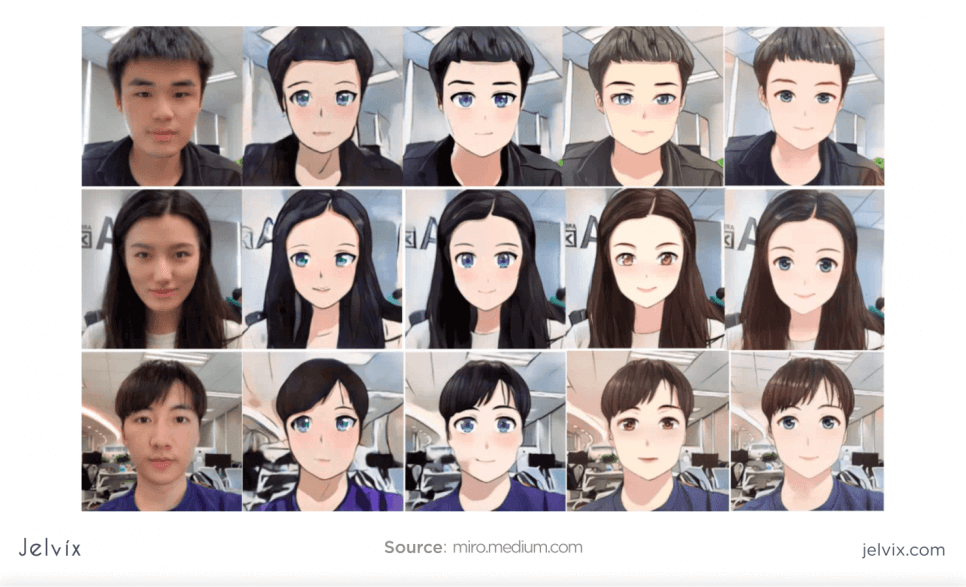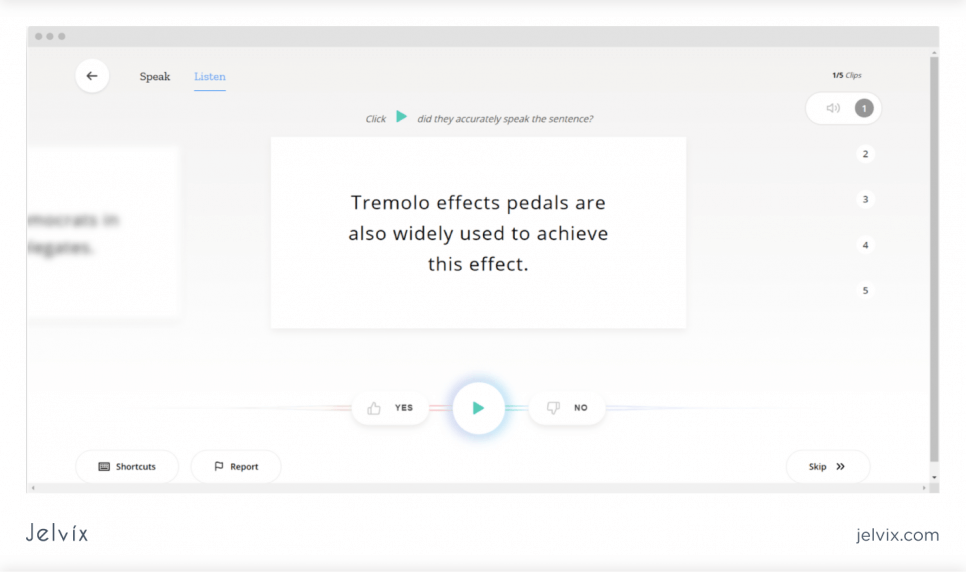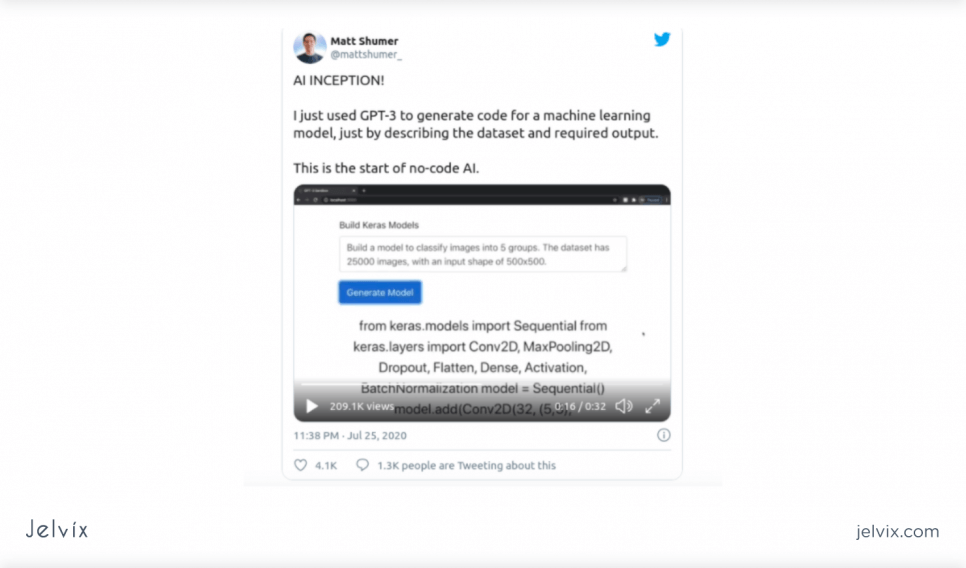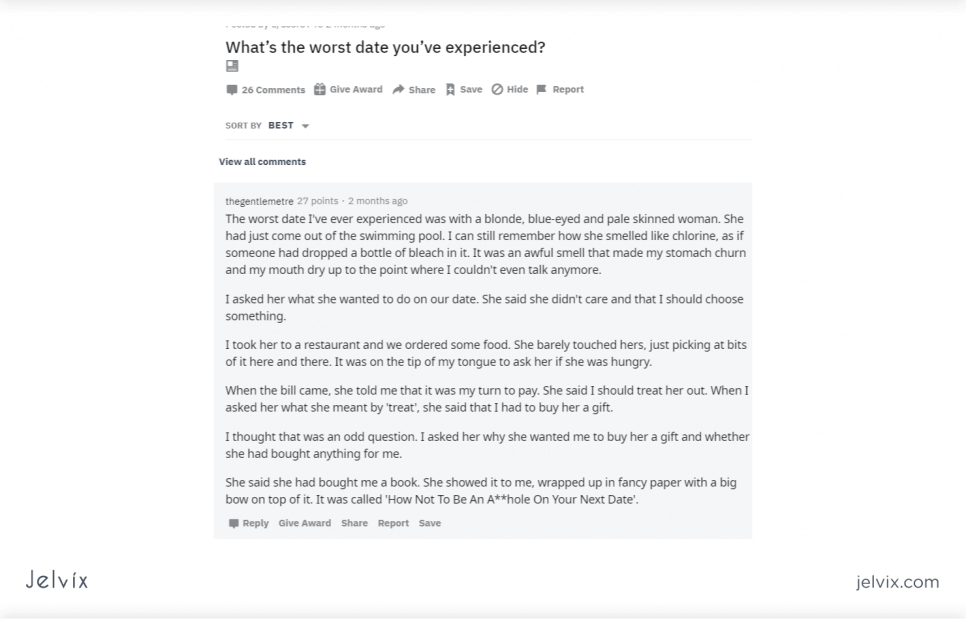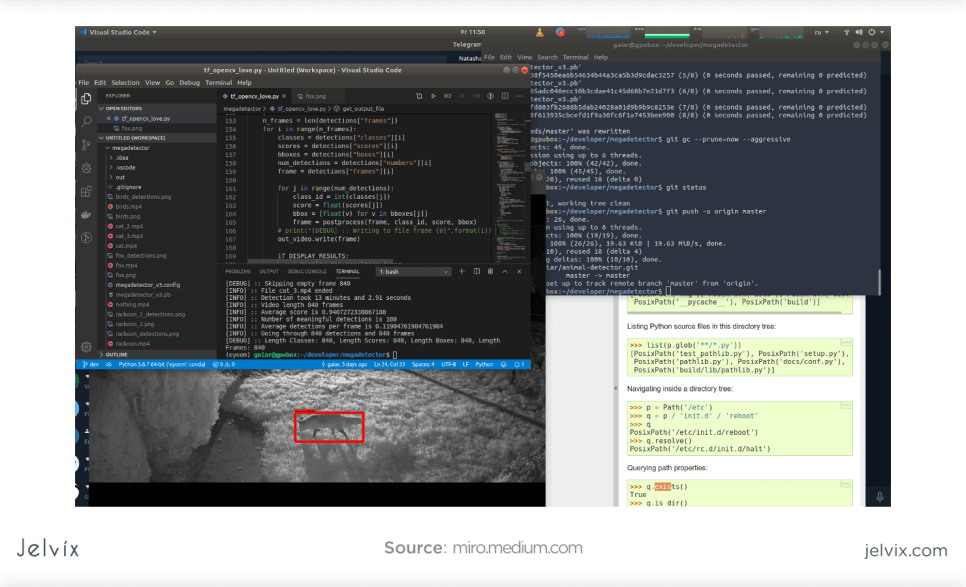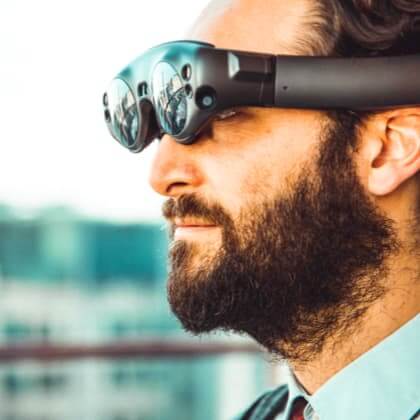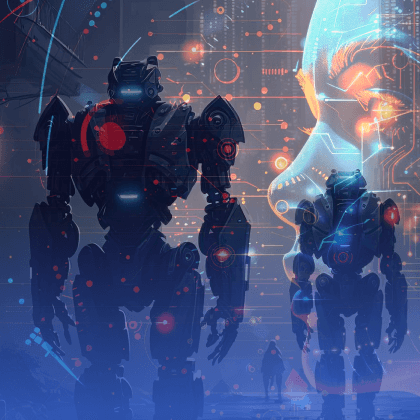For the longest time, AI is perceived as a revolutionary technology with the potential to solve complex real-life problems. Often, Artificial Intelligence steps in where other technologies get overwhelmed with the complexity of the task.
The first goal of using AI is solving a problem. Machine learning projects can be anything, from calculating the chances of survival of fictional characters to diagnosing diseases – and saving real lives. In this article, we’ll take a look at how classical AI problems can be taken to a business ground – and of course, drive revenue.
Basic Artificial Intelligence Projects
Before we introduce the business aspects into our discussion, let’s appreciate the technical capacities of simple AI projects and machine learning datasets. Any machine learning project is based on the dataset – the collection of data on which the ML model will train.
The goal of a data scientist is to write functionality that can apply and interpret a dataset to reach a specific goal. At first, the model has to be trained under careful supervision – it’s important to make sure algorithms work well. Once the system is approved, it can run independently. Progressive improvement is a big selling point of ML projects.
Iris Dataset
To understand the basic capacities of machine learning and data science, developers start by exploring Iris. It’s a dataset that collects information on the size of iris’ petals. A fairly small database (150 raws and 4 columns) allows you to solve object classification by its properties. Solving a problem with the Iris dataset is a data science equivalent of Hello World for programmers.
Iris demonstrates that even a small database is enough to support many conclusions about a group of objects. With a similar dataset, you can build a machine learning system t0 conduct scientific experiments or manage products in e-commerce shops.
Titanic Dataset
A powerful weapon of machine learning and data science is prediction. A classical example of such a machine learning project is a Titanic dataset. Developers need to build a system that predicts who among passengers have the highest and lowest survival chance, generalize survival trends, and create a comprehensive report.
With this database (also a rather small one), you can already arrive at many data-supported conclusions. For instance,
- Women have a higher survival chance than men
- There’s a correlation between ticket price and survival rate: passengers who paid more are more likely to survive
- The majority of kids younger than 10 years old survive (perhaps because they are a high priority)
- Passengers who travel with more than 2 partners have drastically lower survival rates (we can hypothesize that they are trying to locate family members or friends before taking measures for their safety).
Interestingly, the survival rates predicted by the system end up being similar to the movie’s outcomes. In particular, Di Caprio’s character almost didn’t stand a chance even according to AI.
Using AI to Solve Practical Challenges
This is all surely fun and games, but you still might be wondering about the practical purpose of this all. How can a business owner leverage machine learning to build a product that fulfills tangible needs? What are the domains where ML shines? Let’s see the possible new ML applications and experimental conditions for their execution.
So, 10 Machine Learning project ideas and real-life case studies – from saving lives to building very profitable software.
Idea 1 – Diagnosing Parkinson’s with Machine Learning
Statistics show that around 10 million people have Parkinson’s disease worldwide. It’s the second most common degenerative illness after Alzheimer’s. In the US alone, the financial losses estimated to be caused by Parkinson’s (treatment, disabilities, inability to work) amount to 25 billion dollars.
A major problem in the diagnosis and treatment of the Parkinson’s is late diagnosis. Patients are often unaware of their condition until serious impairment starts to occur. They tend to miss early cues – like changes in voice, handwriting, posture, etc. Machine learning could help detect those signs and diagnose the disease on its onset.
The solution is to build an application that will detect changes in voice or hand movements and catch Parkinson’s in time.
The drawing to the left belongs to the Parkinson’s patient – the difference is pronounced
Tools: the dataset for such an application already exists. The collection features 195 recordings of patients with various stages of the disease. It also has biometric data and proven medical analysis. The development team can start training the system with this dataset. As the application diagnoses more patients, such innovative projects on machine learning will create a much bigger dataset for continuous learning.
Idea 2 – Improving Video Call Experience with ML
In 2020, Zoom took over personal meetings at work, school, hobbies. According to Tech Republic’s research, a recent poll showed that Zoom fatigue is a real phenomenon. Users are distracted from the call, multitask instead of concentrating, and tend to be quiet, where they’d usually speak up.
People find Zoom meetings monotonous and feel uncomfortable about showing their faces close up to the camera. This problem could be solved by making Zoom meetings less formal, more unpredictable, and engaging.
Machine Learning potentially gives an out-of-the-box solution. With ML, you can build an application that uses virtual faces instead of real ones. It introduces the element of surprise (breaking the Zoom fatigue) and removes the concern of facing the camera at a close angle. The avatar will repeat all the movements and mimics of the user, but it won’t directly expose facial features.
TikTok has been doing this for a while with great success. Here’s an AI-based anime filter that went viral this year. Real faces are substituted with anime versions of a user. A similar thing has been done with emojis – but not on Zoom yet.
Idea 3 – An Even Smarter Speech Recognition
There’s never enough progress that can be done in Speech to Text and Text to Speech recognition. The way we think and speak is challenging. Our sentences often don’t follow semantic, grammatical, and phonetic rules – so recognition software needs to analyze practical material.
When teams build voice assistants or recognition and ML tools, they often face the problem of accounting for slang, mistakes, and switching between languages (which is typical for many bilingual speakers).
ML systems and datasets offer a solution: you can use community-based datasets for multiple languages and build self-learning speech recognition tools. Such a technology can be used in learning software, voice assistants, navigators, virtual bots, etc. All you need to do is use an existing dataset (or create your own), validate the correctness of conversion until the speech algorithm doesn’t produce desirable results.
Tools: Mozilla manages free datasets for SST and TTS recognition and allows users to validate recordings. You can contribute to the dataset as well, validating any language you know. For your ML project ideas, you can use these growing libraries and get started immediately.
Idea 4 – AI-based Content Making with GPT-3
Creative writing seems to be challenging to replicate. After all, we see creative abilities as our species’ distinctive quality – especially when expressing ideas verbally. However, AI comes very close to reaching the human level of proficiency – mainly due to GPT-3.
GPT-3 is an algorithm for natural language processing created by Open AI (a company co-owned by Elon Musk). It has been riding the wave of popularity in AI development for several years already – and results are promising.
Examples of using GPT-3 and Machine Learning
- Answering user questions. A typical problem of a chatbot is its detached logic. A user asks a question, and a bot provides a ready-made answer that barely touches the subject. Since responses are pre-written, there’s always a risk of running out of them – if the question doesn’t fit. However, with GPT-3, AI can understand a question and independently generate a meaningful response.
- Creative writing. Human creativity is complicated, but after analyzing a few thousand datasets, AI can quickly get the hang of the most common tropes and metaphors. With GPT-3, there have been projects of AI writing poetry, song lyrics, stories, etc.
- Writing code. A startup founder built a layout generator entirely with the help of AI. Of course, GPT-3 doesn’t write complex code yet, but it’s getting progressively better. It even knows data science programming languages – in particular, Python.
Another application of GTP-3: building an AI with an AI – no coding required
Another intriguing scenario is the use of GPT-3 based bots on social media. Users often don’t have proof of the authenticity of other users and comments. If a machine learning system managers to mimic people based on dataset analysis, it’s not a given that all users will differentiate. This is exactly what happened when a bot went on Askreddit, pretending to be a real user.
Bots can be philosophers
Using GPT-3, a developer built a service that answers complex philosophical questions. The perspective of a bot is entirely different from that of a human. For instance, a question of “How to get rich?” gave an unsettling answer – you should either sell yourself or your children into slavery.
What is the quality of such content creation?
Bots write texts that are easily understandable and can do it in different contexts. Of course, they still lack the natural flow – perhaps, the system still lacks experience and sufficient validation. With the example of a Reddit bot, you can easily see that although a text is understandable, it seems too logical. The structure of the sentences is too precise and lacks filler – typical for human users. Also, no user would type such a long text 2 seconds after the question was posted.
Idea 5 – Using GTP-3 to Do Routine Writing
The existing technology is already versatile enough to allow business owners to build a realistic natural language processing system. The use cases are countless – from chatbots and virtual assistants to any content-making business (writing, poetry, communication).
In the future, bots might answer repetitive emails, write short notes, create text summaries, etc. Any routine writing work might end up automated in the future – and you can leverage that to work smarter and faster.
People don’t like reading long letters – AI can help by relaying the main message, saving your time.
Solution: an AI bot can analyze the content of the inbox and detect the most important emails. Such Artificial Intelligence project ideas can have different twists and turns. To make replying easier, it can automatically write the body of the email from the headline. For instance, for the headline “I’d like to apply for a job”, a service could be able to create an entire cover letter based on a user’s personal information and qualifications.
Idea 6 – Detecting Objects, Animals, People
Monitoring the safety of property is a responsible task. Even now, when automation grows faster than ever, companies and individuals still pay a lot for security – although it falls into the category of routine work.
Using Artificial Intelligence and Machine Learning for these purposes has a lot of advantages. Not only there’s no chance of human error, but also, you don’t need to deal with turnovers, sick days, disabilities. Also, AI is much more accessible – even an owner of a small apartment can “employ” an AI security app to assure safety.
Using a camera and Raspberry Pi, a person managed to find out what wild animals drink water from his house fountain. This one might not be a relatable concern, but there are many instances where a similar too can be applied. Just take a dataset that fits your needs and build a notification system that goes off once the object is detected.
So, to build such a tool, you’ll need a microprocessor, camera, image transport system (like ImageZMQ), and a Machine Learning algorithm. You can create a custom filter that will command the software to “stop showing notifications with certain objects”. If you are building a tool that detects people, you might want to ignore squirrels and pigeons.
Idea 7 – Trying on Clothes (yes, even in action)
Some users are wary of buying clothes online because they aren’t sure about sizes and colors. According to Internet Retailer, 14,9% of US online customers never buy clothes online. Even with the 360-degree preview models and photo-based try-on systems, users are still skeptical.
Machine Learning provides a way to solve this problem by allowing users to try clothes on via video. It makes sense – because only with natural body movements we can see if a piece fits. Here’s how it’s done by the team of Max Planck Institute and Facebook Reality Lab.
Idea 8 – Generating Textures and Patterns to Help Designers
Designers, art directors, illustrators are always looking for new patterns, textures, and color combinations. Human creative vision is highly influenced by trends and sometimes fails to produce a fresh perspective. So, when creatives get stuck, they can use AI and Machine Learning to generate new pattern ideas.
Such startups already exist; however, they are still pretty basic – not to mention that patterns aren’t the only application. A similar logic can be applied to create mood boards, storyboards, inspiration decks, brand books. Visual creativity, just like creative writing, can become much more accessible.
If you are interested in exploring other business ideas related to generating new patterns and styles, we suggest taking a look at generating art. It’s a field dedicated to applying AI to creative generation, and there’s a lot of Artificial Intelligence project topics to explore.
Idea 9 – Leveraging ML’s Predictive Power to Invest Better
Can an ML system give a 100% precise insight on emerging “new Bitcoins” or predict Zoom-like stock spikes? Not really – some events are emergent and don’t follow typical patterns. However, that doesn’t mean that you can’t use AI to make smart financial decisions – even if they won’t be sensational.
Problem: Investors often struggle with monitoring multiple trends and examining risks. The financial climate is always changing – especially if we consider the international market. However, to an AI and ML-based system, this information won’t cause overload. They will quickly go through large datasets and define solutions that statistically promise the best financial outcomes.
Solution: a smart investing application that analyzes trends on the market and offers data-driven investment advice. You can expand it beyond just stock market dynamics and train your AI to analyze a particular industry’s trends and statistics. Track overall GDP dynamics – all to understand the global economic environment.
If your business is generating gradual sales or is in high-growth mode, this article will be perfect for you as it will guide you properly to ML in Demand Forecasting.
Idea 10 – Generate Ideas
If you are reading this article, you are exactly the target audience for such an application (or a web service, that’s up for your consideration). Everyone (and business owners in particular) understands the value of ideas. The good ones are creative, but beyond that, they derive from real-life trends and real data.
When humans ideate, we often fail to account for all trends and risks. We are not immune to cognitive biases – once we develop an idea, our attachment eclipses rational judgment. However, ML and AI don’t experience these difficulties. Their ideas will be data-driven, impartial, and free of biases.
To understand how it could be done, take a look at this initiative on the Product Hunt. However, it’s not the ultimate service. You can think of your perspective to generate and tailor a field to a particular audience. After all, to generate precious ideas, it’s best to be domain-specific. This way, AI will be able to keep up with relevant trends and provide a realistic perspective.
P.S. These ideas were suggested to you by a human writer… or were they?
Conclusion
Machine Learning is growing every year, and 2023 won’t be an exception – far from it. The impact of COVID-19 drives companies to consider automation for as many fields as possible. As human contact becomes a deficit, we need our services to get smarter. These business ideas are highly relevant for building the link between intelligent technology and everyday problems.
So, if you’d like to implement some of those innovative Machine Learning projects in real life, get in touch with our data scientists. If you have another idea or would like us to help you generate one, don’t hesitate to start a conversation. We’ll gladly share our experience and knowledge to help you bring ML innovation to your users.
Need a qualified team of developers?
Ramp up your development resources to reach new business objectives.




